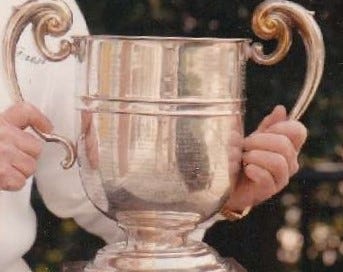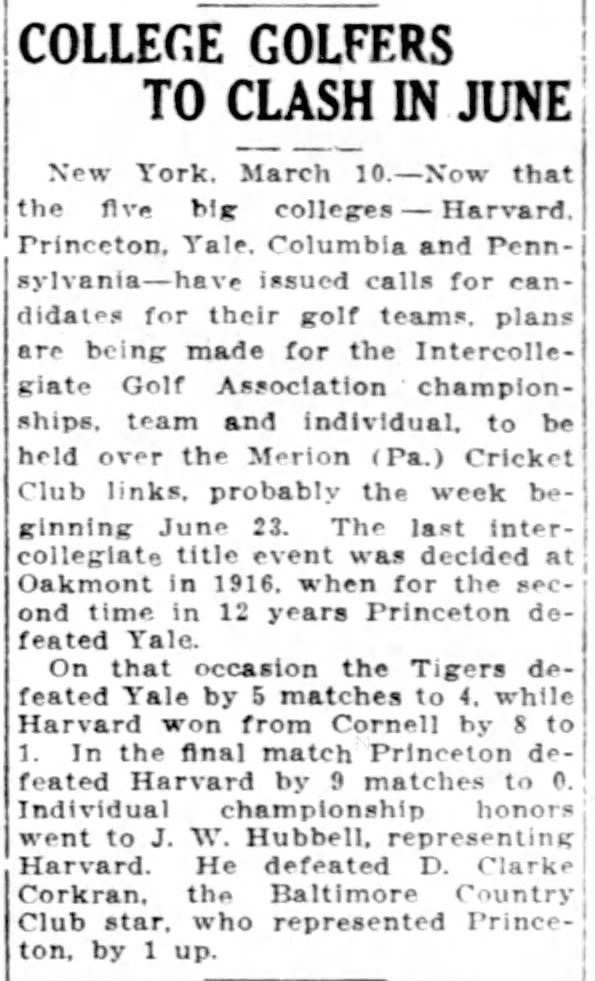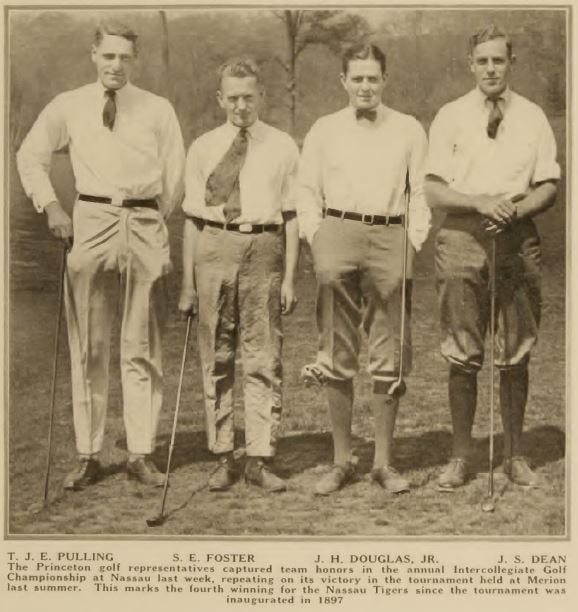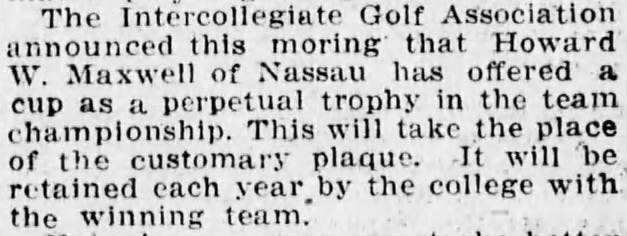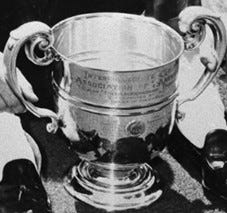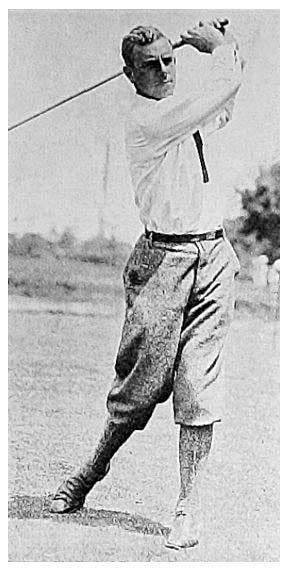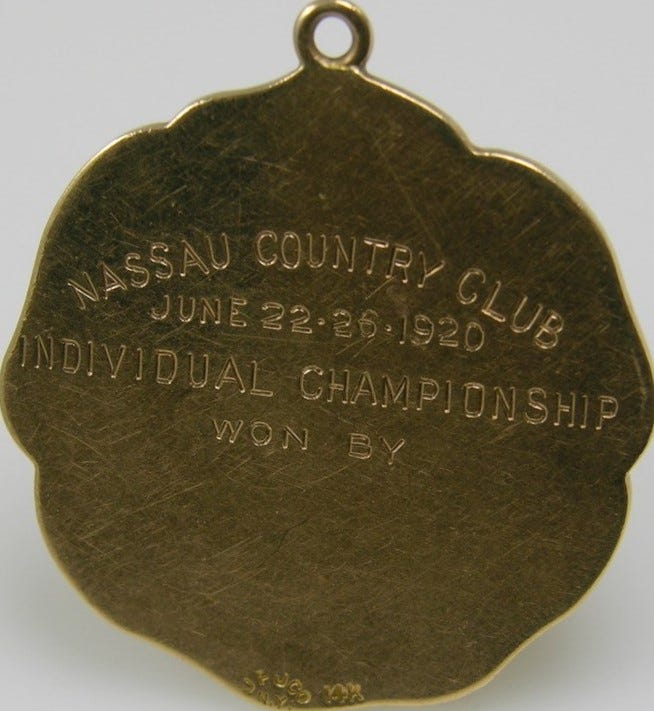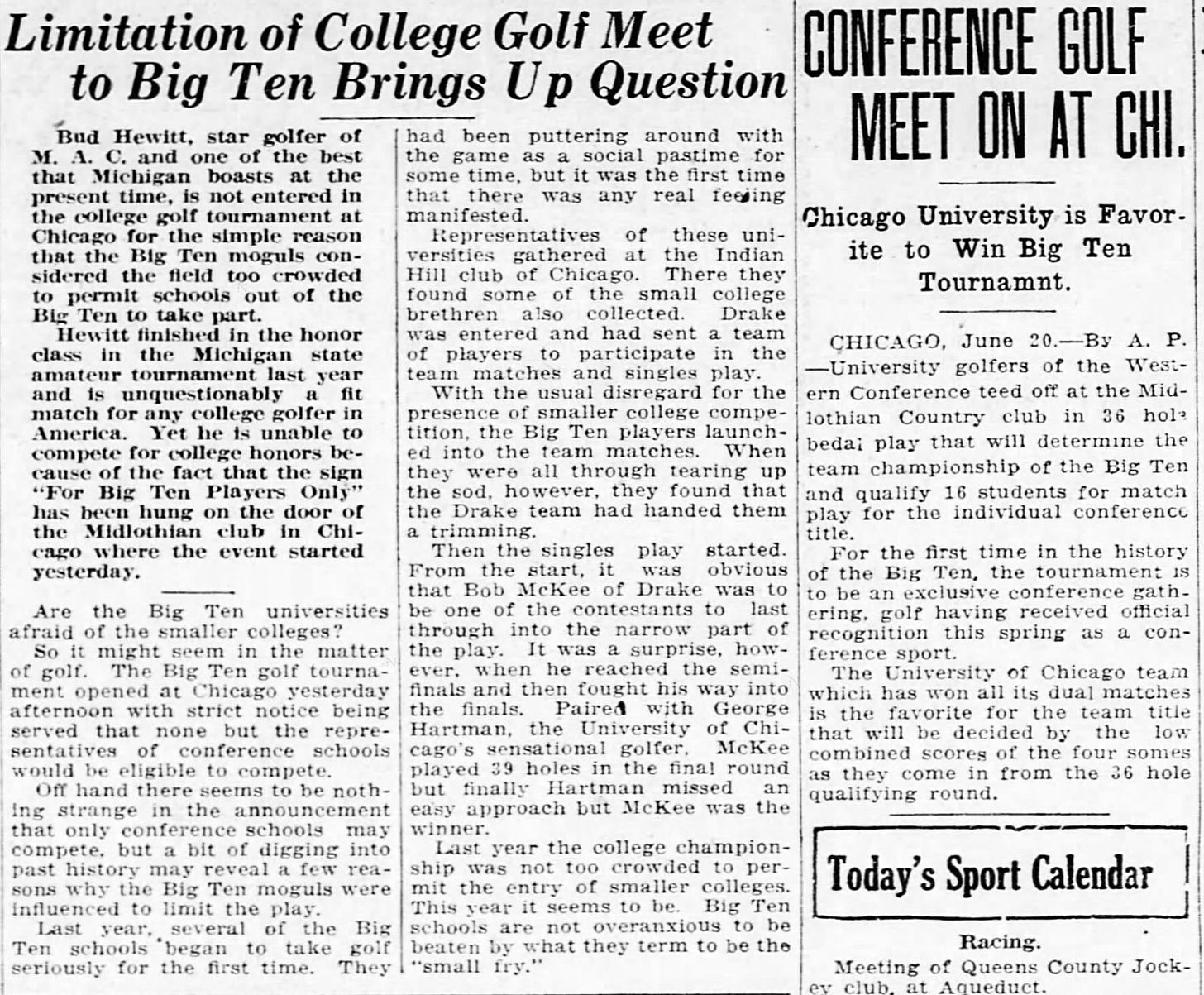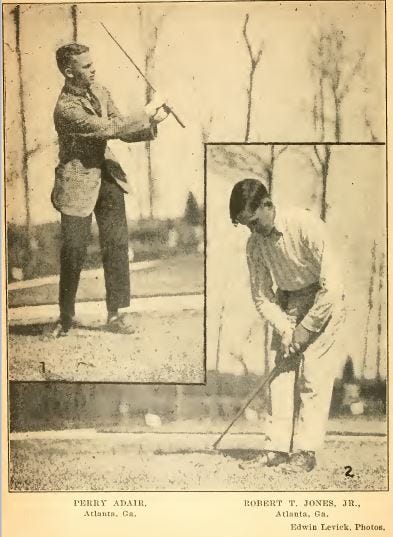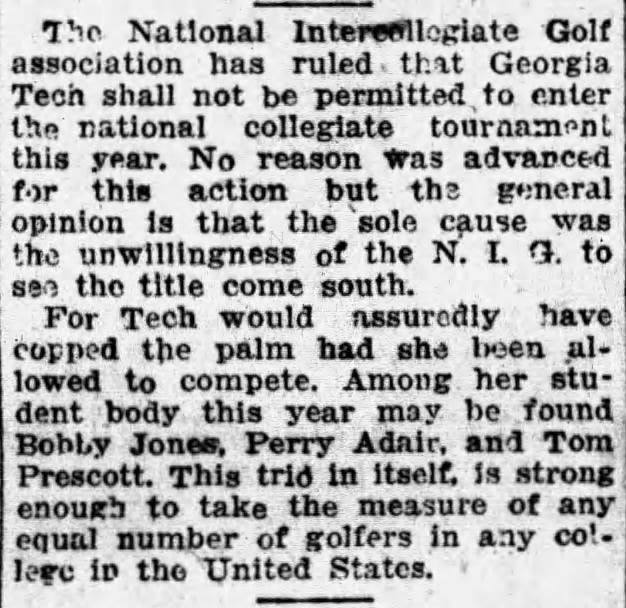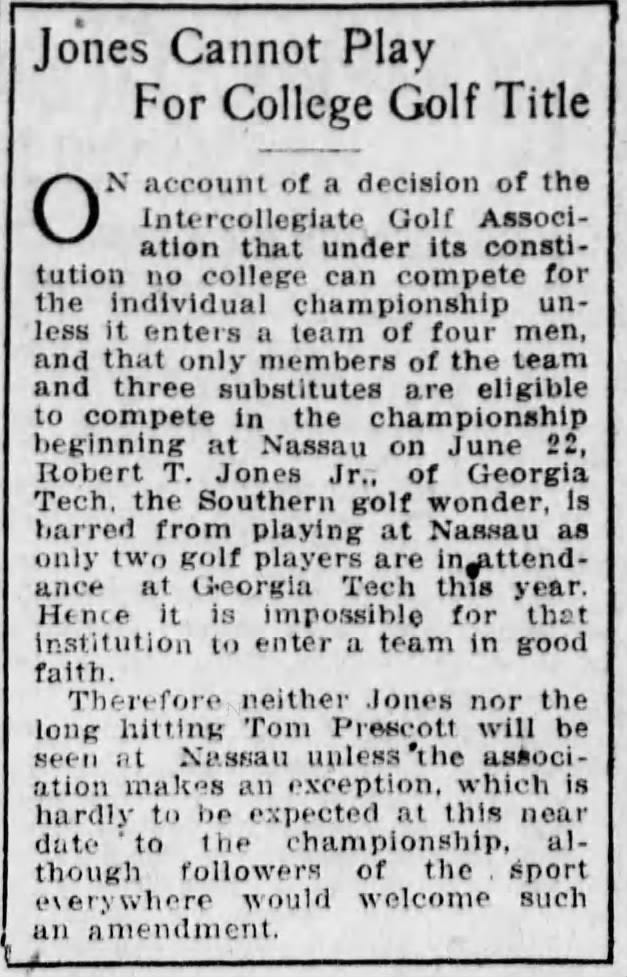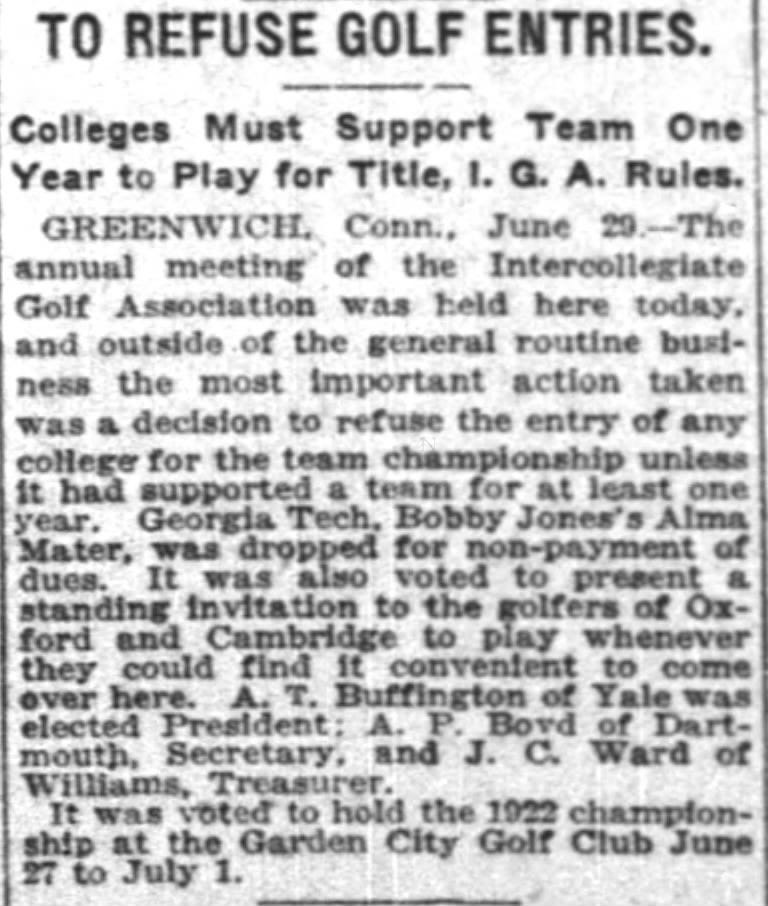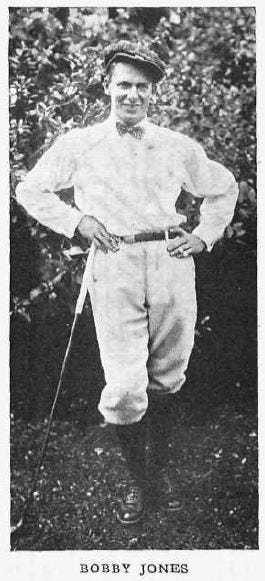This is part of a series on the Men’s Collegiate Championships
IGA Championship Era: 1897-1938
College golf is back! It’s slow going at first with Dartmouth and Columbia being the first to get back into the swing of things, but the rest of the IGA universities followed suit and pretty soon plans were made for the first post-war championship in 1919 (finally held at Merion).
The return from WWI brought an opportunity to make many changes including switching seasons back to the Spring/Summer, dropping team match play in favor of medal (stroke) play, and increasing the number of individual match play slots. It wasn’t just the tournament itself that changed, the IGA also gained representation in the USGA in 1921 so that the IGA President would double as the committee member on Intercollegiate Affairs, an important step in formalizing the relationship between the organizations and a move that would eventually lead to the USGA taking over responsibility of the tournament.
Intercollegiate Championship #23: June 22-26, 1920
Host: Nassau CC (Glen Cove, NY)
The last time Nassau hosted was 1907 when Yale swept honors
Format
Team stroke play
Day 1 = 36 holes
Day 2 = 36 holes
**doubles as the individual qualifier
Individual match play (32 players, random draw, 18 hole matches)
The first increase in MP slots since 1901 when moved from 8 to 16
Results
Team Champ: Princeton (4)
Princeton got off to a hot start and never relinquished the lead over 72 holes to win a third straight title dating back to the 1916 championship. The team that went 18 tournaments without a win now had 4 in the last 5, racking up victories at Garden City, Oakmont, Merion, and now Nassau.
A New Trophy for the Champ: The Maxwell Cup
On the day team championship play started, Howard Maxwell Sr - Nassau club President and father of Princeton’s Maxwell Jr - announced his donation of a new perpetual team trophy to replace the existing trophy/tablet donated by the USGA in 1905. The Maxwell Cup was put into rotation starting with the 1921 championship and would be passed between winning teams - who would inscribe the names of their champion squad - until sometime in the 1980s. At the time of this writing the whereabouts of either of these trophies is currently unknown (which is a damn shame).
Medalist: J Simpson Dean [Princeton]
Princeton captain JS Dean was no stranger to Nassau CC having won medalist honors at the club’s prestigious 1919 Invitational Tournament. Less than a year later he led his team to a championship over a field of some of the best young players in the country, 12 shots clear of the next closest player - James Ward [Williams] (315). Already one of the favorites, Dean looked destined to win it all when he took down the reigning champ (AL Walker, Columbia) in the Quarterfinals, but he ultimately fell short against Jess Sweetser in the Semifinals. Dean got his revenge in the 1921 championship where he not only became the first repeat medalist but also defeated Sweetser in the individual Finals.
Individual Champ: Jess Sweetser [Yale]
Yale’s freshman phenom Jess Sweetser, who calls Ardsley (site of the first 3 championships) home, almost wasn’t allowed to play as the IGA had contemplated not allowing freshman to participate. A relative dark horse to start the championship, Sweetser quickly became a favorite when he won his Quarterfinals match 9&7, the largest victory in a non-finals match since Chandler Egan won 9&8 in a 1903 match. This was solidified with his victory in the Semifinals over the medalist JS Dean. On the other side of the bracket another freshman, James Ward [Williams] - who joined the team to play in this championship instead of defending his Missouri state title - defeated the other remaining Princeton player to set up a very interesting Final. Sweetser was in control from the start and, despite a valiant comeback from Ward which included an eagle 3 on the 32nd hole, took the championship 4&3.
Jess Sweetser would go on to have an incredible amateur career including a runner-up finish in the 1921 IGA championship, winning the US Amateur in 1922 (def Chick Evans at The Country Club at Brookline), and in 1926 became the first American to win The (British) Amateur. Sweetser would be a mainstay on the Walker Cup - playing on the first team in 1922 - and served the USGA later in life.
Championship Award Count
EXTRA HOLES: Drake and the beginning of conference golf
Just like the IGA, the WIGA took a break during the war years, however unlike the “national” body the latter would not return. In its place, the schools of that region - who mostly belonged to the Big Ten Conference in sports such as football - started a similar but ultimately different golf event that was more closely related to the conference. The first “Western Intercollegiate” was held in 1920 and included most of the BIG TEN conference schools as well as Drake (the ultimate winner). Although this tournament only featured two-man teams and includes teams outside of the conference, the official Big Ten record book lists it as the first Big Ten golf championship.
The 1920 Drake squad was lead by Robert Knepper, who won the individual title. He enrolled at Princeton the following February (another golf-specific transfer?), eventually helping that team win an IGA title in 1922 and himself earning the individual medalist honor. Drake would repeat as “Western” champs in 1921 a month after winning the 1st ever Missouri Valley Conference championship with team captain Robert McKee winning the individual championship in the former and his teammate Ted Payseur winning the latter. Drake was also admitted into the IGA that same year and would finish 3rd in the team stroke play after leading the first 36 holes but unable to outlast Dartmouth (their first title!) down the stretch despite the high individual finishes from McKee and Payseur. The next year, 1922, the Western Intercollegiate would become the Big Ten championship as it was officially closed off to non-conference members, perhaps in part because of Drake’s success. Meanwhile, the 1922 Drake team would repeat as Missouri Valley champs with Robert McKee winning the individual title. Unfortunately, one of the Drake starters was ruled ineligible (likely scholastic reasons) and therefore the team didn’t compete in the IGA championship.
As we can see, Drake played an fairly significant role in not one but two early golf conference championships. One of their players, Ted Payseur, is going to be a significant contributor to college golf in the coming decades in much the same way as Chick Evans.
EXTRA HOLES: Bobby Jones
Robert Tyre “Bobby” Jones burst onto the national scene as a 14-year old, making it to the third round of match play (by defeating Eben Byers!) in the 1916 US Am at Merion where he eventually lost to Robert Gardner. Jones would of course go on to become one of the most successful amateur golfers ever, winning his first US Amateur in 1924 and becoming a national sensation. Between those two events, Jones attended Georgia Tech where he joined Perry Adair and Tom Prescott on one of the South’s only university golf teams. Despite his and the team's growing national recognition, a very interesting (and frustrating) set of events would prevent them from competing for a collegiate championship:
1918: Georgia Tech becomes a nationally recognized collegiate team with two well known players: Perry Adair and Tom Prescott. After a successful tour of matches against the Eastern schools, Georgia Tech petitions for inclusion in IGA. The admittance vote at the annual meeting (at or after the championship) was expected to be just a formality, but when the IGA championship was cancelled, Tech’s entry was delayed another year. That Fall, Bobby Jones would matriculate into the university and join his friends on the golf team.
1919: IGA rules that Georgia Tech will be inducted into the organization, but WON’T be allowed to play in the championship due to the traditional one-year waiting period between admittance and playing. There must not have been too many hard feelings because Tech did another tour, playing against the Eastern teams in a series of matches (which they mostly won). While the IGA championship was being played at Merion, Bobby Jones and Perry Adair were playing in the prestigious Southern Amateur at the New Orleans Country Club.
1920: Georgia Tech announces early that they are not going to play matches against Eastern teams this year. There is a random report sometime in March that Jones would transfer to Harvard, however he squashed this with an announcement that he wasn’t going (yet). Georgia Tech announces in April that they would send a team to IGA championship but by the time of the tournament only two players, Jones and Tom Prescott, are able to go; Perry Adair went to British Am which Bobby Jones had declined. The IGA ruled that since they’re not competing in the team event then they can’t compete as individuals, which is VERY interesting to say the least because over the years there have been several instances where IGA member schools only have individuals and even cases like 1916 where non-members were allowed individuals to play. Just speculation on our part, but there is likely bad blood here now.
1921: Georgia Tech is dropped from the IGA due to non-payment so no chance of playing in IGA championship. Our best guess is that they probably didn’t see the point in keeping membership based on past treatment and the fact Bobby Jones had decided to travel to the British Am this year anyway.
1922: There were reports early in the year that Bobby Jones would be competing as an individual at the IGA championships, signaling perhaps that something had been worked out. Whether it was ever going to actually happen or not remains unclear, but by the time the championship rolled around Jones, who had just graduated from Georgia Tech and was recovering from a “minor” leg surgery, was instead busy winning the Southern Amateur at his home course (East Lake) in Atlanta, GA.
1923: After graduating with a degree in engineering from Georgia Tech last summer, Jones enrolled in Harvard in the fall semester and once again announced his intention to play in the next (1923) IGA championship. Unfortunately, it was determined that since he already held a degree he was no longer eligible to play on the Harvard team and thus couldn’t compete in the IGA championship. According to this detailed account by his grandson he still wanted to be a part of the team so he took the job as an assistant manager whose primary jobs included cleaning spikes and guarding the team whiskey! For winning the US Open later that year, Bobby Jones was awarded the coveted “H” without ever hitting a shot for the Harvard team.

So there you have it, 5 years and 5 unsuccessful attempts at playing in the IGA championship, each year encountering a new rule obstacle. Who knows what would have happened if he and the Georgia Tech teams (especially 1919) had been allowed to compete, but in any case the missing collegiate title makes for a curious hole in his otherwise historic amateur golf career. We will see Bobby Jones’s presence loom in several interesting ways over the next decade (plus) of collegiate golf.
Thanks for reading!
Up Next:
In the next post we will cover the 1927 championship where another Georgia Tech sensation (and Bobby Jones protégé) finally gets an opportunity to showcase Georgia golf. To give more context, we touch on the sudden rise of conference championships throughout the country.

